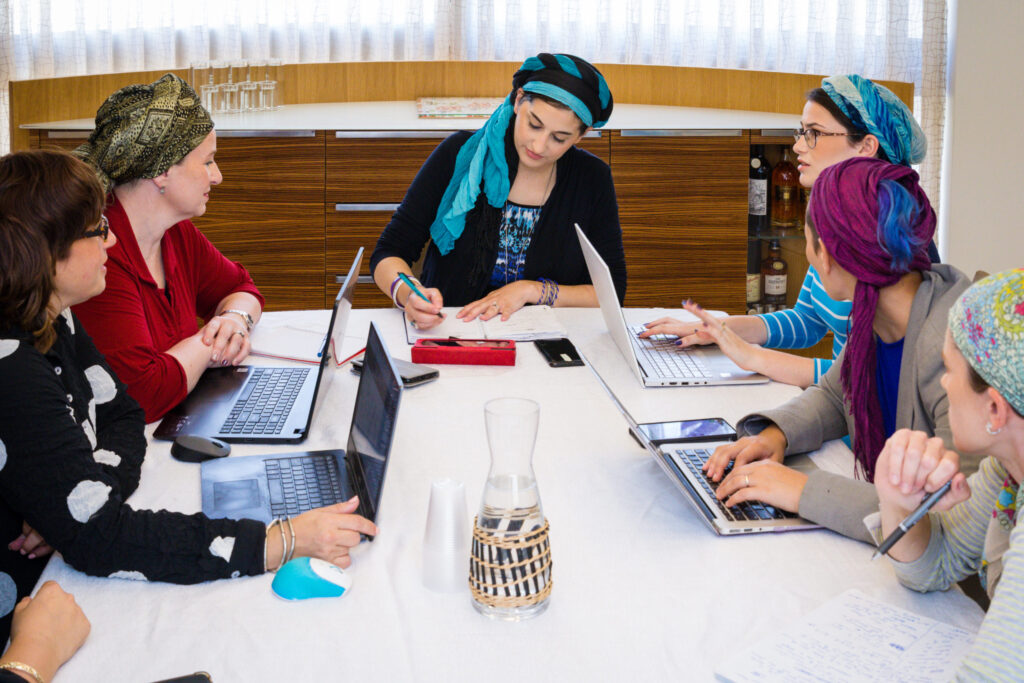Originally printed in the Metro magazine of the Jerusalem Post
View PDF of article as it appeared in the Metro magazine of the Jerusalem Post, August 14, 2015
Females are increasingly absent or outright removed from advertising throughout the haredi community – and progressively, among the national-religious community as well. ‘Metro’ explores the deeper issues, and the radicalization of influential factions within the ultra-Orthodox sector – throughout Beit Shemesh, the country and the greater Jewish world
Imagine a world without women. No mothers or daughters. No female doctors, MKs, teachers or even real estate agents. No girls swinging on playgrounds or young women going to school.
Open one of the numerous pamphlets or magazines in towns around the world with large haredi communities – from Bnei Brak to Lakewood, New Jersey, from Betar Illit to London – and that is what you will find. Even the magazines created for women, like Mishpacha and Bina, have no women or girls in them.
This phenomenon has also come to the town of Beit Shemesh, where, in addition to many haredim and traditional Israelis, there lives a vibrant, Zionistic immigrant population. Recently a group of such residents, concerned with the increasing radicalization of the town as seen in the women-free pamphlets in certain areas and some “women to the back” bus lines, decided to take action – and found more than they bargained for.
Purim costume ad blurs girls faces
Advertisement for a sale on children’s Purim costumes blurs out the little girls’ faces. (Shoshanna Keats-Jaskoll)
The group made calls to publications that censor women in an effort to understand where the practice originated, and to let them know that refusing the right to advertise based on gender or race was illegal. The group was then informed that pressure had been exerted by certain community rabbis to censor images of women so as not to offend local citizens.
Concerned with the capitulation to extremists, and not wanting to support discriminatory publications, the group created stickers for their mailboxes asking delivery people not to leave the circulars at their homes. A posting on Facebook has since generated over 100 requests for the stickers.
Group member Alisa Fox Coleman explains her motivation for involvement: “I do not want ‘no women’ to be seen as the norm. It is damaging for both my son’s and daughter’s health, and it is also illegal.”
One of the arguments that those who want to censor women’s images have used is that the lack of a picture in an ad does not negatively affect business or put the advertiser at a disadvantage.
However, local businessman Rafi Goldmeier, who uses his photograph to advertise, asserts that “anyone who says a picture doesn’t make a difference in advertising is either lying or ignorant. Since adding my photo to the ad, people come up to tell me they recognize me from it and how nice it is. There is clearly an advantage to using a picture.”
AT AROUND the same time, English-language coupon booklet Metziah recognized a niche market: circulars that would print images of women and allow both sexes to advertise their businesses similarly. They began distribution to mainly Anglo areas in Beit Shemesh.
Almost immediately, calls and letters poured in, decrying the two ads that featured women.
Metziah received a letter from a rabbi in the city’s Ramat Beit Shemesh Gimmel neighborhood, stating that the publication of females in pictures offended the haredi population and that it should stop featuring them. If the publishers refused to censor women, he continued, the booklet would have to stop its deliveries to Ramat Beit Shemesh Gimmel.
The publication also received a call from the office of a rabbi in the Ramat Beit Shemesh Alef neighborhood, echoing the same sentiments. He added a thinly veiled threat that if Metziah did not desist, it could well suffer a sudden a loss of advertisers. Metziah made it clear that it would not discriminate against women and girls, nor would it stop distribution to entire neighborhoods.
There was a new flood of phone calls and emails. The formulaic wording of the calls made it clear that a campaign had been waged to harass the publication. Advertisers pulled out. Though apologetic and philosophically aligned with Metziah, the departing businesses were afraid of losing the hefty support of those campaigning against it.
When the circular continued to publish images of women, people delivering it in Ramat Beit Shemesh Gimmel were surrounded one night by ultra-Orthodox men and threatened. After that, Metziah was dispatched via the post office so as not to put anyone in harm’s way.
Modesty or control?
In discussions of this incident on Facebook, people – including self-described haredim – expressed outrage and disbelief at the bullying and boycotting tactics. It then came to light that the same Ramat Beit Shemesh Alef rabbi who had called Metziah and arranged a boycott was responsible for the near-firing of a local healthcare manager a few years earlier.
In that case, someone had deemed her dress immodest, as she did not wear stockings. Every day, men came to the clinic to see what she was wearing; there were demonstrations outside her workplace, and her husband was threatened. When her boss asked her to capitulate to make peace, she told him she would agree to wear stockings through the long, hot summer – as long as he did the same. The clinic put her on paid leave until the situation calmed down (which it eventually did).
Health funds have begun to cater to this phenomenon by publishing brochures with only men and boys; so has the Israel Electric Corporation.
The more such things are done, experience shows, the more it becomes the norm – and the more it becomes the norm, the more extreme people become. Indeed, a few months ago, someone spray painted over the word “isha” (woman) on a sign for a women’s health clinic.
When incidents such as these are brought to the attention of the municipality – headed by controversial Mayor Moshe Abutbul – many excuses are given for its inaction. Often the city claims that it is a police matter, or that due to the population, the city is limited in what it can do. This was the claim during the Orot Banot school harassment debacle of 2011, and the reason the issue had to be taken to the national media in order to get resolved.
The municipality finally appears to have taken down the signs requesting that in certain areas women walk elsewhere, as ordered by both a judge and the attorney-general. Immediately after the signs were removed, random spray painting cropped up around the city exhorting women to dress modestly.
Asked about the issue of erasing women and using threats to enforce modesty, a hassidic man from Beit Shemesh, speaking on condition of anonymity, says, “Today, more than ever, we need to ascertain if pictures of women are forbidden or permitted. If it is permitted according to Halacha” – which, he asserts, it is – “then it is not okay to make it forbidden. When you forbid things that are permitted, people say, ‘Forget it all, [the Torah] is all made up!’”
He adds, “I don’t think there is a problem with a normal picture of a woman. Someone who sees a problem with this should perhaps check if there is something wrong with himself. This type of behavior causes hatred between people; people see fanatics, and assume we are all this way.”
The man stresses that “this thing with women is not about religion, it is about control. How do I know? Because the Torah’s paths are pleasantness and peace” – a reference to Proverbs 3:17. “Whoever is making threats, bargaining with fear, this is not Torah. It is about control.”
Menachem Schloss, a haredi therapist in Beit Shemesh, describes the effect that extreme gender segregation can have on a person.
“I recently treated someone who could not have marital relations with his wife. He described growing up with men eating in one room and women in the other; men received double portions. All his life, he saw women as ‘less than,’ as unworthy. Suddenly he was expected to marry and be intimate, yet he didn’t know how to see a woman as desirable. Clearly this is an extreme case, but it illustrates where we are going with this erasing of women.”
Asked to elaborate on what results from removing females from society, Schloss responds starkly: chaos.
Schloss was also the recipient of phone calls concerning Metziah, as he advertises there. The therapist made it clear that he would not obey the boycott.
Not everyone stood as strongly, however. Metziah lost about 40 percent of its advertisers due to the campaign against it. Moreover, people were spotted tearing the circulars out of mailboxes and throwing them away in the middle of the night.
Many who heard of the boycott’s results called the publication to lend support, but the damage was done: The publication has since shut down and is now suing the harassers in a rabbinical court.
In online conversations throughout the incident, people wondered where this type of control and harassment might lead.
Publication removes realtors image
A paid ad for a Beit Shemesh realtor who employs a female agent and wanted to include her picture, but the publication would not allow it. The ad just repeats her name. (Shoshanna Keats-Jaskoll)
Veils?
After the most recent Knesset election in March, ultra-Orthodox newspapers such as Hamodia and the Shas Party’s Yom Leyom, as well as a publication called (ironically, in this case) Actualia and the website B’Hadrei Haredim, altered a photo of the new government so that the faces of the female ministers were either pixellated or removed entirely.
Rebbetzin Dr. Adina Bar-Shalom, daughter of late Shas spiritual adviser Rabbi Ovadia Yosef, expressed horror: “I fear that if this continues, we will have to veil our faces.”
She recounted how her father reacted with shock and anger upon seeing a published family photo with the faces of his wife and mother blurred out.
“What nerve… what is this supposed to be? Ultimately they’ll all be in veils,” she recalled him saying.
Was Yosef speaking in hyperbole? Does extreme modesty in print necessarily translate into real life?
A look at the facts: Haredi women suffer a 30% higher rate of breast cancer mortality than other women, and an unwillingness to educate on “immodest” topics is often the reason. Haredi women are ranked eighth for life expectancy in Israel. Haredi men? Second. Moreover, when the Knesset Committee for the Advancement of the Status of Women convened to discuss women’s health in this community, not one of the haredi MKs (all men) showed up.
As mentioned, even the word “isha” has apparently become taboo. Hamodia, in an article on the makeup of various Knesset committees, altered the name of the above committee to the “Knesset Committee for the Advancement of the Status” – twice.
This emphasis on female modesty is making waves among women. One reaction is to buy in, with an increasing number of women wearing “shawls” – a poncho-like piece of fabric worn over clothing so as to conceal any suggestion of the female form. A small group of Jewish women has become known for wearing burkas and covering their little girls from head to toe in black cloth – though this group has drawn condemnation even from the stricter segments of haredi society.
Other women have had enough of their leaders putting the weight of the world’s problems on their shoulders, elbows and knees. In the last election, thousands of haredi women threatened not to vote unless a woman was put in a realistic spot on the ultra-Orthodox lists. Moreover, a political party of haredi women, Ubizchutan, even ran for Knesset (though it received much media attention, it failed to secure any seats).
These movements of haredi women seeking female representation – either within the extant ultra-Orthodox parties or in the new women’s party – agree that the men who claim to represent them do not.
People all over the country have been documenting the vanishing-women phenomenon, using social media to publicize pamphlets and booklets that censor women and girls – from IEC safety booklets, to health clinic pamphlets, to travel guides for religious families (sponsored in part by the government).
Internationally, in hassidic communities in New York and London, women are expected to refrain from driving – an unofficial ban. Even world tragedies are blamed on women’s supposed lack of modesty: It is not uncommon to see signs correlating a house fire, a natural disaster or the number of ambulance calls (this in Lakewood) with wigs that are too long, skirts that are too short, or nonexistent socks. As rockets rained down on Israel last summer, a New York camp for young girls ran a modesty contest for its participants, claiming that covering their bodies would protect Israel.
What do Jewish sources say?
Proponents of the obsession with modesty maintain that women are holy and must not be objectified or gazed upon, or cause men to sin; therefore, women must be covered, hidden, unseen. These are also the reasons used to demand that women and girls sit in the back of buses, private and public.
However, Jewish sources that discuss the idea of shmirat einayim (guarding one’s eyes) make several points explicitly. The obligation to guard one’s eyes is incumbent on men, who must keep their thoughts pure; women, while expected to be modest – as all Jews are – are under no obligation to disappear.
Rabbi Moshe Feinstein, a widely respected halachic decisor among American Orthodox Jews, made this clear in his response to a man’s question regarding sitting next to women on public transportation: “There is no prohibition to come into contact with them [women] since it is not done in a sexually arousing manner… If it is known that this will bring about lustful thoughts, then he [the questioner] should refrain from traveling… He needs to fight against these thoughts.”
Eighteenth-century scholar Rabbi Haim Volozhin discusses the paradox of lustful thoughts, maintaining that when a man commits to never looking at a woman, his desire will burn like fire. The very thing he seeks to avoid will come to dominate his mind.
Schloss sees this as well.
“A clear result of extremes in tzniut [modesty laws] is, ironically, pornography. People with such mind-sets [that women should be hidden from view] are far more likely to perceive normal human drives as an addiction issue and will tend to seek out frum [religiously observant] therapists who will diagnose them as sex addicts. It is this perception which often causes immense frustration, anxiety and depression,” he says.
“Of course, the other effect of this is where US studies have shown that citizens of religious, conservative states were more likely to buy porn online,” he continues. “No doubt, if such studies were done here, it would show similar findings.”
To get a current rabbinical response to the forced erasure of women, the action group mentioned above wrote a letter to the country’s chief rabbis. Ashkenazi Chief Rabbi David Lau replied that erasing women and threatening those who did not comply with directives to do so were not actions seen among gedolei hador (great religious leaders), and were “un-Jewish.”
How is this affecting women and girls in Judaism?
International author and speaker Lori Palatnik – who is responsible for bringing more than 6,000 women to the Jewish state to explore their roots through the Jewish Women’s Renaissance Project – says she is “highly concerned with the ever-increasing disappearance of women and girls in the religious world. For those making baby steps into their observance, the absence of pictures and names of women and girls is confusing and disconcerting.”
The outreach activist adds that “I did not experience this when I began my journey to Torah, and was able to enter in a healthy way with incredible female Jewish role models. I respect the desire for modesty in a greater world that is becoming increasingly profane, but a healthy balance must somehow be reached.”
As one educational therapist in Beit Shemesh explains, “I work in a wonderful all-girls ultra-Orthodox kindergarten. As part of an activity, the girls cut out pictures and words from magazines and glue them to their papers. I have had girls ask me, ‘Where are the pictures of mommies?’ or ‘Where can I find a picture of a girl like me? I don’t want only boys in my picture!’”
There is no question, she maintains, “that five-, six- and seven-year-old girls need to see people in print with whom they can identify. Particularly for children with self-esteem issues and self-image issues, such deprivation of healthy imagery only exacerbates the damage. Our children need print pictures of females to identify with and model [themselves] after.”
Women around the world are waking up to this increasing practice. In many communities, synagogue directories have pictures of only the husband. When couples are honored, only the man is presented with the award. Even wedding invitations have only the fathers’ names printed.
Many do not like where this is going, and are asking, “Why does this continue when it makes no sense?”
Their points: If erasing women is not bringing more holiness; if it creates a reality where women’s needs are not met; if the ways it is done are not pleasant, but threatening and harsh; if the rabbinic sources of yesterday and today reject it outright as un-Jewish; if women’s reactions to it are further extremes and anger; if girls are feeling lost, confused and left out; and if it thwarts those working to show the beauty of Judaism, then it is clear that this practice is causing far more harm than good, and is not protecting the Jewish people.
Schloss contends that the real effects of erasing women will not be seen in this generation, but in the next. The children are the ones who will suffer from the chaos that is created, he says.
In the end, many argue, it is up to those who recognize that expunging women is far more damaging than it is positive. If the community speaks out against the practice, conveys this to its leaders and does not support those publications that delete women, then perhaps this phenomenon can be stopped – before Schloss’s words come true.





